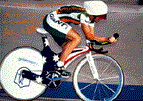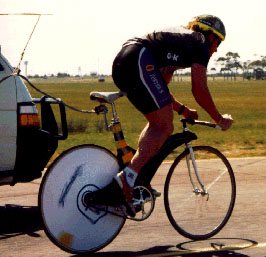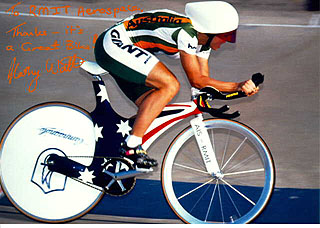| Engineering
the World's Fastest Bicycle |
 |
|

|
By
Mr Lachlan Thompson FIEAust.
Research Leader Sports Technology, Department of Aerospace
Engineering,
Royal Melbourne Institute of Technology, Melbourne, Australia |
ABSTRACT:
Australian track cyclists won impressive victories at the
1995, '96 and '97 World Track Championships and the 15th Commonwealth
Games. The Australian team used with stunning effect a unique
carbon fibre monocoque bicycle designed and built by a project
team from the Royal Melbourne Institute of Technology (RMIT
University) and the Australian Institute of Sport (AIS). Developed
in consultation with Charlie Walsh, the national track cycling
coach, this new bicycle, the 'AIS/RMIT Superbike', has allowed
the Australian riders like Shane Kelly to set new records.
Continued development has resulted in over twelve World Championship
titles and four world records. Including the World record
for the kilometre Individual Time Trial set by Shane Kelly
in 1995.
The
development and application of new wind tunnel testing techniques
have resulted in a fifteen per cent reduction in power over
the traditional diamond frame. Extensive use of a water tunnel
and wind tunnel have enabled the team to optimise the frame
profile for minimum aerodynamic interference from the rider's
leg motion. Structural design loads were derived from track
testing with strain gauged frames. Finite element analysis
techniques were validated through extensive material testing.
Throughout the development program extensive use was made
of validated performance simulation. The simulation provided
evaluation of stiffness, aerodynamics and weight. These simulations
enabled rapid assessment of concepts. Track testing with power
meters and strain gauged frames were used to refine design
data and wind tunnel test techniques.
In
order to produce the resulting bicycle new manufacturing techniques
had to be developed. Unlike most equipment used by elite athletes
the AIS/RMIT 'Superbike' has been designed for low cost, high
volume manufacture. The hollow frame is moulded as a single
unit in a one shot process suitable for automation. The frame
was designed to accept standard group sets and wheels. The
AIS and RMIT University has lodged patents on the unique features
of the manufacturing process. Bicycle Technologies Pty Ltd
(Australia) has commenced commercial manufacture of track
and road variants. The New Zealand National Track Cycling
Team has selected the 'Superbike' for the 1997 and 1999 seasons.
It is anticipated that the technology will enable a new manufacturing
industry to be developed in Australia.
The
engineering development has resulted in the project winning
an Engineering Excellence Award from the Institution of Engineers
Australia, two Innovation Awards and the 1995 Velo News Award
for "Best Technical Development for 1995 in Road or Track".
This paper discuses the engineering techniques, research and
project management required to create the Australian Superbike.
DESIGN CRITERIA
The
stunning ride by Chris Boardman on the Lotus Bicycle(1)
in the Barcelona Olympics heralded a dramatic change in Olympic
track cycling. The UCI's rule change opened the door for the
monocoque bicycle to show its potential. Unlike the much later
Lotus Sport, Boardman's bicycle was a one-off with highly
specialised components. His ride did however set the stage
for a new era in competitive cycling
As
Chris Boardman rode to Olympic Gold the RMIT and AIS project
team set out to build a 'Superbike'. The RMIT-AIS team sought
a design that optimises weight, stiffness and aerodynamics
while conforming to the rules of the Union Cyclist Internationale
(UCI). The University was at the time seeking a suitable project
to demonstrate new low cost advanced composite manufacturing
techniques. The project team included engineers, technicians
and students from RMIT Aerospace Engineering, the AIS and
RMIT Industrial Design.
Australian
Olympic track cycling coach Charlie Walsh defined the initial
design criteria with the project team in late 1992. The resulting
bicycle must use a conventional group set of standard(3,6)
cranks, bearings, brakes, wheels, forks, handlebars, seat,
etc. Further criteria imposed by RMIT was that the design
must equal or exceed the structural stiffness of a steel bicycle
while offering lower aerodynamic drag and weight without compromising
reliability. It was also desirable for commercial purposes
that the resulting design be suitable for low cost, high volume
production.
| Seat
tube angle |
74
deg. ±0.05 deg. |
| Steering
tube angle |
74
deg. ±0.05 deg. |
| Bottom
bracket shell height |
55
mm ±1.0 below rear axle |
| Out
of plane twist |
±0.05
deg. |
Dimensional
tolerances(6) used in developing the 'Superbike'
In
this project the needs of the end user were paramount to the
success of the end product. Competition bicycles are made
to the rider's individual specific requirements. The client
specifications were defined and completely fulfilled. These
specifications included critical geometry as shown below and
certain subjective characteristics as ride and comfort. Stiffness,
strength, reliability and use of standard components were
achieved.
|
ENGINEERING
DESIGN
A
systems engineering approach was adopted for the project.
A requirement analysis was undertaken to establish the
design criteria and project milestones. The project
plan and budget were developed using the findings of
this analysis. Riding position and frame geometry defined
by the AIS were checked against a current AIS Olympic
steel frame. This same frame was later used to define
minimum stiffness criteria.
|
 |
| Figure
1: Gary Neiwand test rides the strain-gauged prototype
|
|
Before
design could take place a mathematical performance model was
written and validated. The mathematical model was validated
against actual track performances using the SRM dynamometer
crank system. This permitted an extensive analysis of each
component in the bicycle system including the rider. The results
of this investigation showed that the frame and front fork
handle bars to be priority components for research. The requirement
analysis also identified that aerodynamic testing techniques
were not giving repeatable results of sufficient accuracy.
Development of improved wind tunnel techniques was considered
a high priority.
Traceability
in design was maintained throughout the project by maintaining
design files and technical reports on each task. Coupon testing
provided material properties for the Finite Element Models(4)
(FEM). Laboratory tests were used to prove structural details
before progressing to track testing.
Extensive
track and wind tunnel testing was used to validate design
changes. Each phase of the project has required critical evaluation
by both the design team and the national track cycling team.
Decisions were made at project or task meetings to ensure
prompt reporting of results and effective implementation of
new ideas.
Every
prototype was required to undergo structural testing for stiffness
followed by a general inspection. Modal analysis is being
developed as a tool for non-destructive inspection and quality
control. This technique of vibration analysis(2)
will provide a cost effective "finger print" technique
for production quality control.
AERODYNAMIC
DEVELOPMENT
In order to minimise aerodynamic drag new and innovative wind
tunnel testing techniques were developed. This included the
use of artificial legs to accurately study the airflow over
the bicycle. With this unique rig the aerodynamics of the
complete system could be represented.
Initial
investigations showed that the rider's legs dramatically influenced
the flow pattern(6) and resulting drag.
To obtain accurate and repeatable wind tunnel results with
live athletes was extremely difficult. The sensitive wind
tunnel balance required precise knowledge of the centre of
mass in order to apply corrections for induced forces due
to moment couples. In the development of the 'Superbike' the
rider was replaced with a pair of lightweight Styrofoam®
legs. A similar lightweight torso, head and arms could also
be fitted. The rear wheel was driven by an electric motor
beneath the wind tunnel floor. A simple belt drive under the
floor also drove the front wheel. By having the motor and
drive system part of the bicycle accurate and repeatable drag
measurement was possible.
By
May 1993 the project team arrived at a basic conceptual design
for a carbon fibre monocoque bicycle. A prototype of this
design was built for initial testing. Wind tunnel testing
was carried out to refine the aerodynamic shape. The instrumented
prototype was evaluated on the track by world champion sprint
cyclist Gary Neiwand. This testing allowed the engineers to
determine handling characteristics and the loads encountered
during competition. The data obtained was used to optimise
the design.
|
Subsequent
prototypes for testing and competition has resulted
in the 'Superbike' meeting or exceeding all of the design
criteria. Independent tests on the 1994 variant by Dr.
Neil Craig of the South Australian Institute(6)
of Sport at the Adelaide Superdrome showed the 'Superbike'
to require 5% less power than the then current steel
AIS Olympic tubular frame.
Further
improvement was made possible by designing a new wind
tunnel balance. The use of a 'hover board' bicycle mounting
eliminated balance interactions. This technique allowed
further refinement and development of the 'Superbike.
|

Figure
2: Moving artificial legs simulates the disturbed airflow
around the bicycle. |
| Year |
Configuration |
Power
@ 55kph |
| 1988–92 |
Steel
AIS Frame |
584
Watts |
| 1994 |
'Superbike'
XVth Commonwealth Games |
543
Watts |
| 1995 |
'Superbike'
carbon fibre blade forks and wing handlebars World Championships
Bogota |
522
Watts |
| 1996 |
'Superbike'
integrated fork-handlebars World Championships Manchester |
498
Watts |
Progressive
performance(6) improvement of RMIT-AIS 'Superbike'.
PRODUCTION
DESIGN
The requirement study showed that a one-size monocoque shell
could be developed to suit a wide range of rider size. One
single size of the 'Superbike' can accommodate riders from
1600 mm to 1900 mm in height.
The
'Superbike' is unique in that it has been designed from the
outset to be of a shape and structure that can be easily and
cheaply produced in high volume(3).
This manufacturing feature, a 'one size fits all concept',
removes the necessity for multiple and expensive tooling.
The use of a complete monocoque shell gives lower weight and
greater stiffness than achieved in previous racing bicycle
designs. This shell is completely hollow and requires no additional
core material. Careful structural optimisation has allowed
thin non-buckling skins to be used.
Refinement
of the manufacturing technique has allowed Patents(7)
on the process to be lodged. The Superbike is in production
at Bike Technologies Pty Ltd, Melbourne Australia. Continued
success in international competition has assisted the project
in commercialisation(2).
|
UCI
World Cup Colorado Springs USA, 17 Aug 94
Kathryn
Watt 1st 3000 m Ind Pursuit 3:41:91 Second
best ever career time
XV
Commonwealth Games, Victoria BC, Canada, September 94
Kathryn
Watt 1st 3000 m Ind Pursuit 3:48:52 Games
Record by over 3 sec
Brad
McGee 1st 4000 m Ind Pursuit 4:31:37 Games
Record by over 5 sec
Stuart
O'Grady 3rd 4000 m Ind Pursuit 4:35:20 Games
Record
McGee,
O'Grady, 1st 4000 m Team Pursuit 4:10:14
Games Record by over 7 sec Aitken, Woods&
O'Shannessey.
World
Junior Championships Italy, 1995
Shaun
Roberts 1st 3000 m Ind Pursuit
Narelle
Petersen 1st 2000 m Ind Pursuit
World
Championships, Colombia, September 1995
Shane
Kelly 1st 1000 m TT 1:00:613
World Record
B.
McGee, O'Grady, 1st 4000 m Pursuit 4:05:10
R. McGee, O'Shanessey.
Adelaide October 1995
Roberts,
Meany, World Record Junior team
pursuit
World
Championships, Manchester, UK, August 1996
Shane
Kelly 1st 1000 m TT
Kelly,
Neiwand, Hill 1st 200 m Olympic
TT World Record.
|
Competition
results for the Superbike (6,8).
STRUCTURAL
DESIGN
The 'Superbike' for the 1995 World Championships has the provision
for the flush mounting of instrumentation used in performance
trials. This allowed for an accurate assessment of the athlete
and equipment without the need to apply corrections for the
aerodynamic drag of the sensors. The ability to access track
test and race data for a pool of top athletes formed an integral
part of the development program(6).
Data from riders such as Bradley McGee, Kathryn Watt, Narelle
Petersen, Garry Niewand and Shane Kelly ensured that the configuration
was one that would benefit a diverse range of riders and riding
positions, further developing the mathematical performance
model.
Extensive
use was made of Computer Aided Drawing (CAD) to input data
to both Finite Element Analysis(3,4,5)
(FEM) and Computer Aided Machining (CAM) of production tools.
Software used in the project included Cadkey97 and STRAND6
as well as the in-house performance model.

Figure
3: STRAND6, FEM Analysis assisted lay-up optimisation.
|
|
Finite
Element Modeling(3,4) was used
to assist in the optimisation of the structure. This
was validated against the instrumented test bicycles,
which were ridden in competition conditions. Static
strength and fatigue life was of importance, as an AIS
track frame will average 10,000 kilometres of use per
annum. The same bicycle being used in training as well
as in competition. Modal analysis has been introduced
as a means of ensuring that each frame is of consistent
quality. Further development of this method of inspection
is planned.
|

Figure
4: Kathryn Watt wins 'Superbike's' first ever race at
1994 UCI World Cup Colorado Springs USA. |
The
continued successful development(6)
of the 'Superbike' is not due to any one factor being superior.
Instead the credit goes to the application of a validated
mathematical performance model that can rapidly evaluate structural,
aerodynamic requirements and riding position.
REFERENCES
- Hill,
R. D. 'The Design and Development of the Lotus Sport
Pursuit Bicycle', Proceedings of the Institution of
Mechanical Engineers, pages 285 to 294, Volume 207, 1993,
UK.
- Lane,
T. 'Push to the Limit', The Australian Way, pages
84 to 87, November 1996, Australia.
- Wilson,
M. 'Super Roo Sets an Olympic pace', Overseas Trading,
October 1995, pages 6 to 9, Australia.
- Anon.
Australian Students Design Championship Racing Bicycle
Frame', MSCWorld, pages 12 to 14, Volume 5, Number 3,
November 1996, USA.
- Priestly,
D. 'Will the 'Superbike' be the Catalyst for an Aussie
Made Revival?' Bicycle Industry News, page 29, September
1994.
- Thompson,
L. and McLean, B. 'Super Roo Bicycle', Institution
of Engineers Australia, Victorian Division, Engineering
Excellence Awards, Paper, September 1995, RMIT.
- Thompson,
L.A.'Bicycle Frame', Patent PCT/AU95/00444, September
1995.
- Vaughan,
R. 'Australia Dominates Worlds', Bicycling Australia,
pages 44 to 45, November 1995, Australia.
|
![]()
![]()
![]()